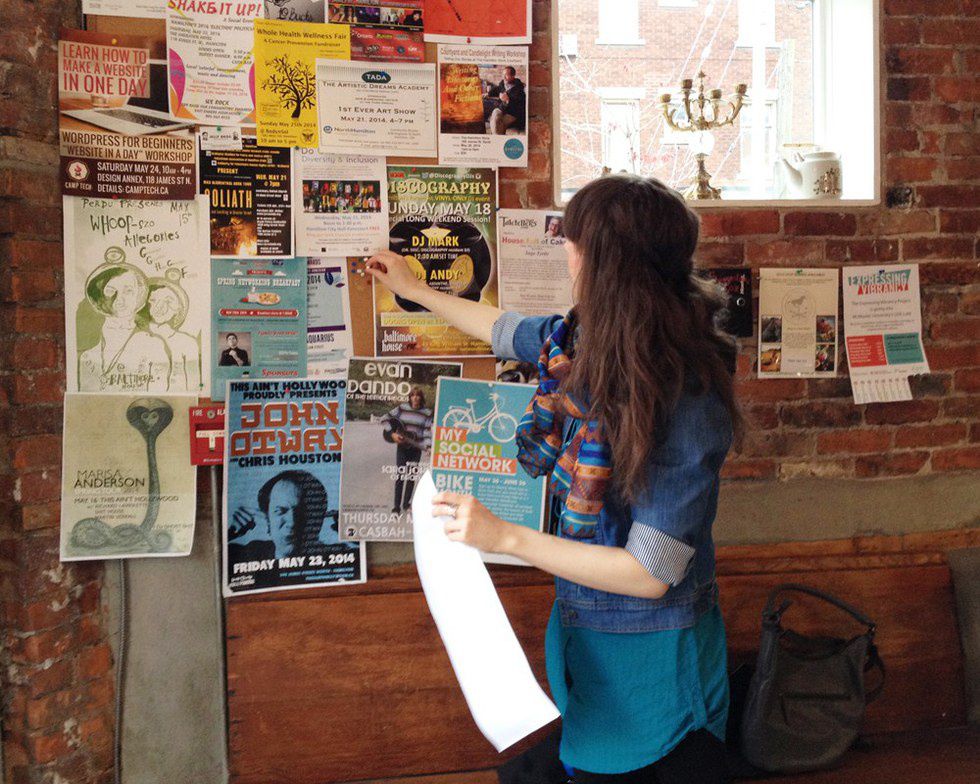Today was an incredible day. I went on another one of my day trip excursions into the city, but not alone, as per usual. I signed up for an event through my university's student involvement center, which was the opportunity to experience the culture and food of Harlem through a food tasting tour. Even though I had to wake up at the most ungodly hour to arrive at school on time for the bus departure, it was worth every moment in the long run.
Upon arrival in Harlem, we exited the bus on 125th St., one of the most iconic streets in all of Harlem. Every inch of that street told a story of past lives, whose essence still lingered through the air, which smelled of the home cooked soul food I grew up having in the South. 125th St. is the birthplace of African-American musical rhythms, and a multitude of top-notch restaurants that have sprouted from the concrete like dandelions in this skyscraper city jungle.
As my eyes wandered the street in wonder, I found one of the beloved restaurants I visited earlier this year -- Sylvia's. The street sign of Sylvia's reminded me of my first trip to Harlem. I was viewing a documentary at a museum on the detrimental effects of slavery's persisting aura in the criminal justice system, with my two friends. Then we decided to grab a bite to eat, with the choices of Chinatown or Harlem, and unanimously voted for Harlem after the revolutionary stimuli we had just received.
After leaving the C train, my friends and I ended up on 125th St., or the "Main Street," and the first thing I noticed was the unusual amount of white people that were roaming the streets. Now, I apologize for being so brash, but I will admit it was not what I expected. I remember growing up with stories of Harlem being filled with drugs, crime, and poverty. All negatives aside, I also learned that it is, or was, the center of the African and Latino American history and culture in America. With all of the activities and racially classified personal connections and associations of Harlem, history would tell you that there is a damn good chance you wouldn't find many white people there.
As you would expect from my preconceived notions of what Harlem was supposed to be like, it only made sense that I expected the latter than what I received. Now again, don't get me wrong. I didn't expect all the drugs, the crime, or poverty, but I also did not expect to see such a huge majority of white people there.
"Now why are there so many white people in Harlem? Why does it seem like you are making this an issue, Tiani?"
Well, if you take a step back and put the man-made racial categories to the sidelines and look at this situation in a third party's eyes, you will be able to see the fundamental issue, right at the core.
As some of you may know, Harlem is going through what we would call: "urban gentrification." What is urban gentrification, you might ask?
"A process of renovation and revival of deteriorated urban neighborhoods by means of influx of more affluent residents, which results in increased property values and the displacing of lower-income families and small businesses." -Wikipedia
And no, it's not a recent trend or something that just simultaneously and innocently happened. None of this would be an issue if black Americans received reparations, after their release from slavery, to help improve their lives in relation to the average white American. Some may say that the government is taking actions with revitalization projects to improve the neighborhood itself, in which poorer black Americans are living in, which they should be "thankful" for.
Why are more white Americans moving into "less desirable areas"? A simple thing called tax abatements. What is a tax abatement?
"Programs that reduce or eliminate the amount of property tax owners on new construction, rehabilitation and/or major improvements would have to pay" -Investopedia
In clearer terms, you will save more money, thousands of dollars a year, if you purchase property in an inner city or lower income neighborhood and "revitalize" it. The government gives you property tax deductions for this action, saving you the 1-3% deduction of your property value every year. This makes your property resale value higher in the long run. "Some cities limit these programs to low-to-middle income property owners, but many programs have no income restrictions." -Investopedia. In particular, New York state only has restrictions on the percentage of tax reductions on your property value based on your income, meaning regardless of your income, you have a chance of qualifying.
Many individuals that live in these lower income neighborhoods simply do not possess the amount of income that is required to keep up with the maintenance that every building needs. The average resident of Harlem makes less than $37,00 per year. The government steps in and makes these tax abatement programs to encourage individuals who do have the means to improve their properties to move to these inner cities. Especially after the housing crisis of 2008 and the growing number of people moving into the city for job convenience or other various reasons, many of the New Yorkers in the lower part of the city cannot afford the increasing prices of the homes for sale or even for rent, and they turn to other areas nearby. For example, near One Morningside Park in Harlem, there are buildings that have condos for the starting price of $2.5 million dollars.
This same gentrifying process happened in the lower level of Manhattan where "African-Americans began moving north in large numbers into the area in the early 20th century after Macy’s, Penn Station and the theater district replaced what had been black neighborhoods farther south." (NYT, Adams, 2016 May 27) Not only are many of the original occupants of Harlem being moved out of their neighborhoods through increasing property values, consumer favorited monopolies start to creep into to enter into the "new" markets that now reside there. Some may argue that these businesses will provide more jobs. I will argue that the new jobs provided are menial to the point where the average American could never receive enough income to provide for their families, especially in an area with increasing housing prices such as Harlem. The jobs that are currently there are the ones of individuals who own and run small businesses.
The main difference between what the residents of Harlem want and what they are receiving is this: what they want is to see improvement of their neighborhoods because of the degradation of its buildings and infrastructure, which is mandated for the government to aide in the up keep with every neighborhood. But when the improvement is expanded so much to the point that the housing prices are increased exponentially to the point where the original occupants cannot live there no longer, the small businesses that the government promised to protect are being torn down, and the children who's family's culture and history is virtually being erased from the ground itself, we have a problem.
As a home owner with a higher income in a lower income neighborhood, not only do you contribute to the extermination of small businesses, but you are eradicating the culture that belongs to that area while forcing your culture on the community. You would nullify the existence of the African and Latino Americans that once thrived there. Seems like history repeats itself. First, it was the Native Americans, and now the African and Latino Americans. We have to face the facts in that we live in a gentrified America. Just imagine the feelings of displacement all of these African and Latino Americans in Harlem must feel.
"To us, our Harlem is being remade, upgraded and transformed, just for them, for wealthier white people."
- Michael Henry Adams, NYT
I always thought America was about tradition, realizing and unifying our differences regardless of your background, and preserving every portion of the heart of our land and our community ideologies. But it seems that the vision I speak of and the vision of what is being executed, has a disparity in it. The fantasy, the American dream of prosperity and community only belongs to those who are white, not to people like me or the black Americans who reside in Harlem. So instead of trying to highlight and embrace their flaws after the abolishment of slavery, they try to erase them. Who knew that, as a child you can grow up believing that now you belong to a most prosperous and affluent nation, to only be heartbroken with the unfortunate reality of being displaced and exiled from it.
So I stand here on 125th St. and take in the amazing view from every angle. I see all the children running around with their parents. I interact with the residents of the community inside the neighboring African markets. I listen to the music being played by street artists with the amazing raw talent that many aspire to achieve. I whiff in all the intoxicating smells that flood the air, realizing that in a few years, it won't be that same as it is now.







 Energetic dance performance under the spotlight.
Energetic dance performance under the spotlight. Taylor Swift in a purple coat, captivating the crowd on stage.
Taylor Swift in a purple coat, captivating the crowd on stage. Taylor Swift shines on stage in a sparkling outfit and boots.
Taylor Swift shines on stage in a sparkling outfit and boots. Taylor Swift and Phoebe Bridgers sharing a joyful duet on stage.
Taylor Swift and Phoebe Bridgers sharing a joyful duet on stage.












